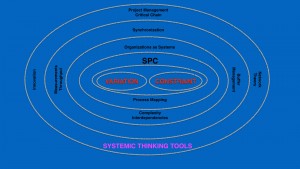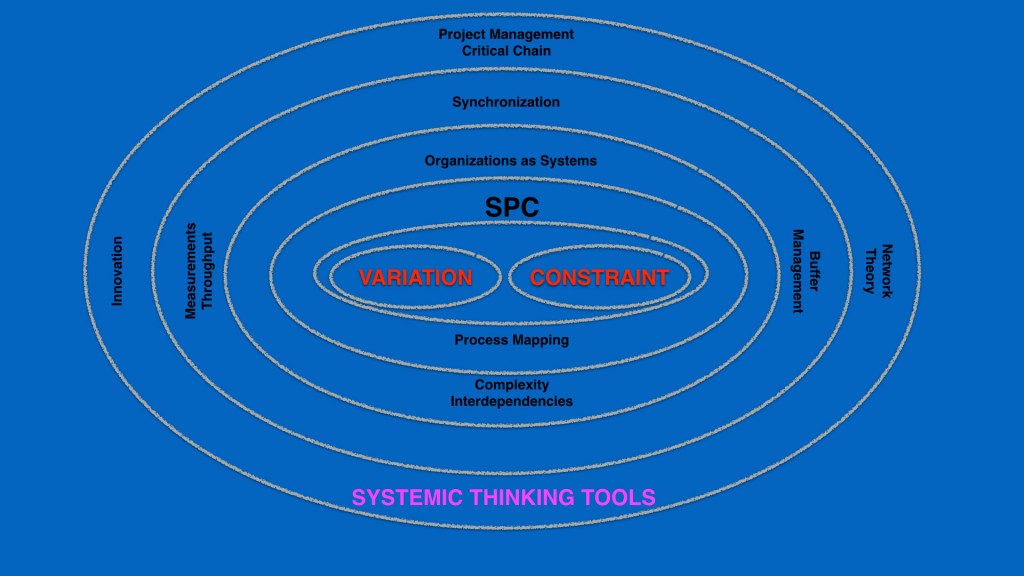Our business world is changing rapidly. Complexity dominates and old solutions no longer work. Some refer to this as the ‘Fourth Industrial Revolution’. Given all these changes, it is remarkable to see that MBAs are offering much the same program content as 20 years ago. We believe that a radical change is needed in the way leaders and managers are educated and trained. We need a new curriculum for business and management. In order to thrive in our complex reality, we need to acquire a systemic understanding of what organizations are, how they work and how they can interact effectively with their commercial, social and physical environment. What would such a curriculum look like? Here we give a brief overview.
A Systems View of the World
The introductory phase of the program would concentrate on grasping a systems view of the world. This is the major shift that leaders and managers need to understand. Reality now is complex; this means that phenomena develop through a network of interdependencies and these interactions give rise to emergent properties in a non-linear way. Systems science and network theory are the major contributions from contemporary science that help us to gain an understanding of complexity. Leaders and managers need to be up to date on this knowledge in order to keep up. It informs a completely different worldview from the one that was suitable for a traditional, mechanistic approach to organizations. (A clear explanation of this shift in worldview can be found in Fritjof Capra’s books, The Web of Life and A Systems View of Life.)
At the Heart of a Systems Approach: Variation and Constraint
The inner core of the curriculum would be made up of two elements that are fundamental for understanding and managing the organization as a system: variation and constraint. Without a thorough grasp of these two concepts and the myriad of their ramifications there can be no rational management. Variation affects all the processes in any organization, whether people are aware of it or not. Fortunately, it can be understood and this understanding can be put to good use through mastering a major offspring of the theory of variation called Statistical Process Control (SPC). Process mapping and understanding how processes produce reliable or unreliable outcomes dictates all the managerial actions that need to be taken to exert effective control over any business system that would otherwise be unmanageably entropic. We can thank W. Edwards Deming for explaining relentlessly why we should do this (and Don Wheeler for explaining how.)
The work of Dr. Eliyahu Goldratt has explained that every system has a constraint, again, whether we are aware of it or not, and the constraint dictates the pace of the throughput produced by that system. We can therefore optimize the performance of the system as a whole by identifying or, even better, strategically choosing a constraint, and then design all the processes to subordinate so that the constraint can perform to its maximum. We protect the performance of the constraint with a buffer to ensure constant performance. Any slowing down of the constraint translates into loss of throughput.
The Centrality of Project Management
When we have a thorough understanding of our business processes, we know how to get them into a statistically predictable state and we have identified a constraint, then we open the gateway to a very powerful approach to organizational design based on projects. Projects are in fact the very essence of the nature of organizations. We can look at all the work an organization does as project-based. The organization therefore becomes a network of projects where everyone is either a resource or a project manager, or both over different projects. Therefore, a fundamental part of the education and training of leaders and managers must be in effective Project Management.
Despite the existence of various certified bodies of Project Managers, the current reality is that the majority of projects executed fail to deliver on time and within budget. Dr. Eliyahu Goldratt who developed the theory of Constraints provided us with a revolutionary systemic algorithm as well as comprehensively and well tested procedures for managing projects called Critical Chain.
Let’s be clear. The CEO and the C-suite are essentially master project managers. The Network of Projects is not a “bandaid” for hierarchy but a replacement where control is exercised though synchronization. The buffer, which harnesses the power of covariance, is the method we use to control activities according to plan. These are the foundational elements of knowledge that can be fully understood and put into practice if managers and leaders tap into a higher level of consciousness.
New Thinking, New Cognition
An organizational design based on a network of projects controlled by buffers and monitored statistically to prevent the system from “exploding” does indeed require a cognitive shift. People within the organization need to tap into a higher realm of understanding of their role and view themselves as part of an organic, systemic, synchronized oneness. In order to facilitate this tapping into a higher level of consciousness, everyone has to fortify their ability to think systemically and systematically tackle unchallenged and often obsolete mental models. To do so, they need to develop intelligent emotions. Indeed, the new skills required for the fourth industrial revolution are very much to do with the cognitive flexibility needed for continuous innovation.
We will look at the part of the new curriculum for business and management connected with how this higher consciousness, cognitive flexibility and intelligent emotions can be nurtured and developed in our next post.
About the Author
Angela Montgomery Ph.D. is Partner and Co-founder of Intelligent Management, founded by Dr. Domenico Lepore. Angela’s new business novel+ website The Human Constraint looks at how Deming and the Theory of Constraints can create the organization of the future, based on collaboration, network and social innovation.







Leave a Reply